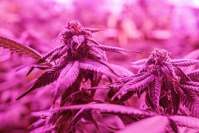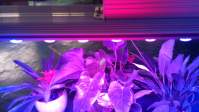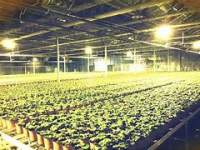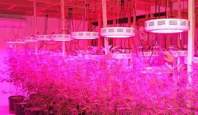Unleash the true potential of plants-1000w led plant light
The sensitivity of plants to the spectrum is different from that of the human eye. The most sensitive spectrum of the human eye is 555nm, which is between yellow light and green light. The sensitivity to the blue light zone and the red light zone is relatively poor. This is not true for plants. They are most sensitive to the red light spectrum and less sensitive to green light, but the difference in sensitivity is not as wide as the human eye. The most sensitive area of plants to the spectrum is 400-700nm. This section of the spectrum is usually called the effective energy region of photosynthesis. About 45% of the energy of sunlight lies in this section of the spectrum. If artificial light sources are used to supplement the amount of light, the spectral distribution of the light source should also be close to this range.
The energy of the photons emitted by the light source varies depending on the wavelength. For example, the wavelength of 400nm (blue light) is 1.75 times the energy of 700nm (red light). But for photosynthesis, the effect of the two wavelengths is the same. The excess energy in the blue spectrum that cannot be used for photosynthesis is converted into heat. In other words, the photosynthesis rate of plants is determined by the number of photons that the plant can absorb in 400-700nm, and is not related to the number of photons sent by each spectrum. But the general knowledge of most people is that the color of light affects the rate of photosynthesis. Plants have different sensitivity to all spectra. The reason for this is the special absorption of pigments in the leaves. Among them, chlorophyll is the most known. But chlorophyll is not the only pigment useful for photosynthesis. Other pigments are also involved in photosynthesis, so the efficiency of photosynthesis cannot only consider the absorption spectrum of chlorophyll.
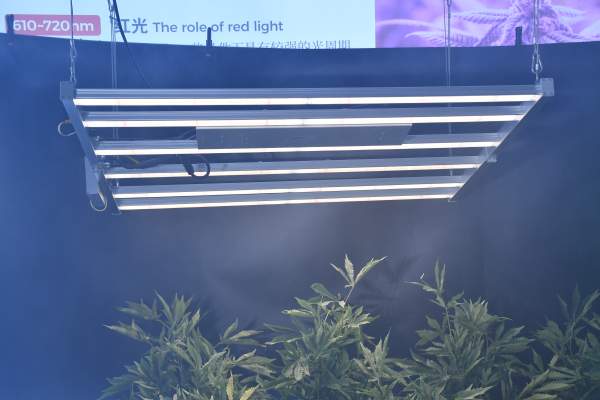
Solar spectrum:
The solar spectrum is a continuous spectrum, in which the blue and green spectrum are stronger than the red spectrum, and the visible light spectrum ranges from 380 to 780 nm. The growth of natural organisms is related to the intensity of the spectrum. For example, most plants in the area near the equator grow very fast, and at the same time, the size of their growth is relatively large. However, the higher the intensity of the sun's irradiation, the better, and there is a certain degree of selectivity for the growth of animals and plants. Several key auxins that affect plant growth have very significant differences in light absorption spectra. Therefore, the application of 1000wLED plant growth lights is not a simple matter, and it is very targeted. Here it is necessary to introduce the concepts of the two most important photosynthetic plant growth elements.
Chlorophyll
Chlorophyll is one of the most important pigments related to photosynthesis. It exists in all organisms capable of building photosynthesis, including green plants and prokaryotic blue-green algae (cyanobacteria) and eukaryotic algae. Chlorophyll absorbs energy from light, and then the energy is used to convert carbon dioxide into carbohydrates. Chlorophyll a mainly absorbs red light, and chlorophyll b mainly absorbs blue-violet light, mainly to distinguish shade plants from sun plants. The ratio of chlorophyll b to chlorophyll a of shade plants is very small, so shade plants can use blue light strongly and adapt to the growth in shade. Chlorophyll a is blue-green, and chlorophyll b is yellow-green. There are two strong absorptions of chlorophyll a and chlorophyll b, one in the red region with a wavelength of 630~680 nm, and the other in the blue-violet region with a wavelength of 400~460 nm.
Carotenoids
Carotenoids (carotenoids) are a general term for a class of important natural pigments, which are commonly found in yellow, orange-red or red pigments in animals, higher plants, fungi, and algae. So far, more than 600 natural carotenoids have been discovered. The light absorption range of carotenoids is 303~505 nm, which provides the color of plants and affects the human body's intake of food; in algae, plants and microorganisms, their color is covered by chlorophyll and cannot be presented. In plant cells, the carotenoids produced not only absorb and transfer energy to help the progress of photosynthesis, but also have the function of protecting cells from being destroyed by excited single-electron bond oxygen molecules.
The spectrum required for plant growth should be a continuous spectrum with a certain distribution width. It is obviously inappropriate to use a light source made of two specific wavelength chips of red and blue with a very narrow spectrum. It is found in the experiment that the plant is There will be yellowish, very light leaf stems, thin leaf stems and so on.
The planting effect of Yaorong Technology 1000w led plant growth light
The difference in photosynthesis path is also not related to color. Light energy is absorbed by chlorophyll and carotene in leaves. Energy is converted into glucose and oxygen by two photosynthetic systems to fix water and carbon dioxide. This process uses the spectrum of all visible light, so the effects of light sources of various colors on photosynthesis are almost the same.
Some researchers believe that the orange-red light part has the greatest photosynthesis capacity. But this does not mean that plants should be cultivated in such a monochromatic light source. For the morphological development and leaf color of plants, plants should be light sources that receive various balances.
The blue light source (400-500nm) is very important for plant differentiation and stoma regulation. If the blue light is not enough, the ratio of far red light will be too much, the stems will grow excessively, and it is easy to cause yellowing of the leaves. The ratio of red light spectrum (655~665nm) energy to far-red light spectrum (725~735nm) energy is between 1.0 and 1.2, and the development of plants is positive growth. However, the sensitivity of each plant to these spectral ratios is also different.
Yaorong Technology 1000wled plant light planting experiment
LED plant lights are often used as artificial light sources in greenhouses. It has the highest energy in the orange-red spectral region. However, the energy of far-infrared light is not very high, so the energy ratio of red light and far-red light is greater than 2.0. However, since the greenhouse still has natural sunlight, it did not cause the plants to become shorter. (If this light source is used in the growth box, it may have an impact.)
In natural sunlight, blue light energy occupies 20%. For artificial light sources, such a high ratio is not necessary. For plants that grow normally, most plants only need 6% blue light energy in the 400-700nm range. In natural sunlight, there is enough blue light energy. Therefore, the artificial light source does not need to add more blue light spectrum. However, when the natural light source is insufficient (such as winter), artificial light sources need to increase the blue light energy, otherwise the blue light source will become an influencing factor for plant growth restriction. However, if the method of improving the light source is not used, there are still other methods to remedy the problem of insufficient light source. For example, temperature regulation and application of growth hormones.
Shenzhen Yaorong Technology Co., Ltd. is a company specializing in the research and development and production of plant lights in my country. It has been engaged in the development, production and sales of led plant growth lights for more than ten years. The products have nearly 10 years of overseas export experience and qualifications. As the most important supplier of plant growth lights in China, the products are also supplied to Europe and the United States for a long time. Tissue culture plant lights and industrial hemp plant lights and modern three-dimensional farm plant supplement light lamps and system applications have a complete and mature plant spectrum technology and Plant fill light application program.
I believe that most people who grow vegetables and fruits in greenhouses have a certain understanding of plant supplement light. The LED plant supplement light is a kind of plant supplement light, which uses the light generated by the principle of diode light to replace the sunlight to supplement the plant.
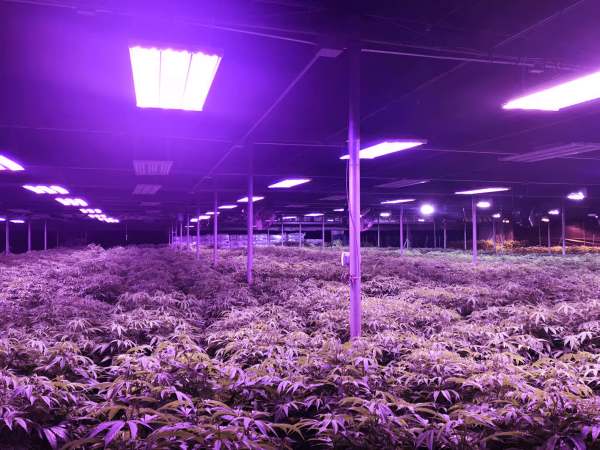
Let's talk about how to choose and use 1000wLED plant supplement light correctly to bring effect to plants.
1. When choosing red and blue lights, we should choose the appropriate ratio of red and blue light for plant growth according to different types of plants.
2. In addition, pay attention to the wavelength range of red and blue light. Red light with a wavelength range of about 660nm and blue light with a wavelength range of about 460nm-480nm have the strongest effect on plants.
3. Different plants have different requirements for light intensity, and the light intensity is affected by power, so we should pay attention to the power of LED plant supplement light when choosing.
4. When using 1000wLED plant supplement light, if the daylight conditions are good, it is only necessary to provide short-term supplement light to the plants in the morning or evening, but at night, the plants need to perform respiration, which is Allow time for the plants to rest. If it is overcast or rainy or hazy, you can use the plant fill light for a long time to fill the plant with light.
The plant supplement light was developed to supplement the light for plants, and the LED plant supplement light is the proof of the advancement of the technology of the supplement light. It is reasonable to exist, which means that the use of the LED plant supplement light is definitely effective. As long as you choose the appropriate plant supplement light and master the correct method of use, I believe your plants will definitely see the effect.


